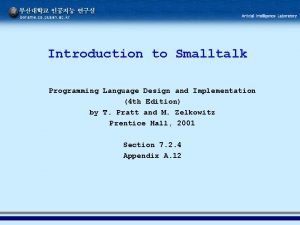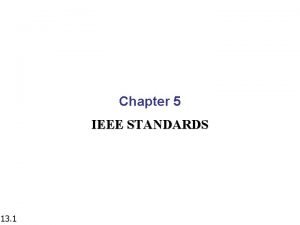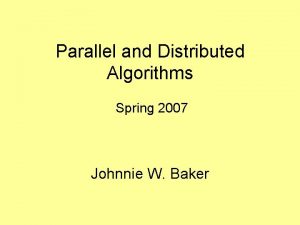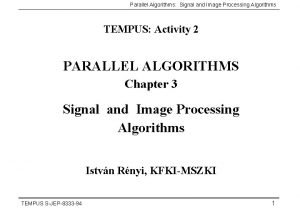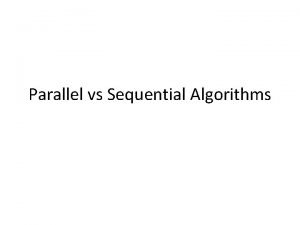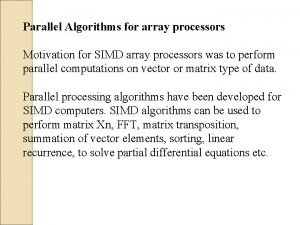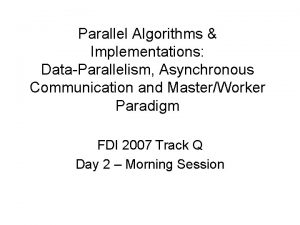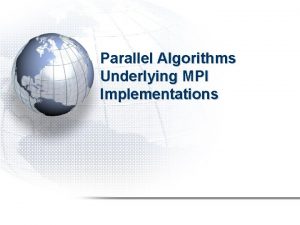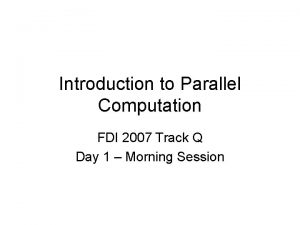Parallel Algorithms Implementations DataParallelism FDI 2004 Track M













- Slides: 13

Parallel Algorithms & Implementations: Data-Parallelism FDI 2004 Track M Day 2 – Afternoon Session #1 C. J. Ribbens

Example: Jacobi Iteration For all 1 ≤ i, j ≤ n, do until converged … uij(new) ← 0. 25 * (ui-1, j + ui+1, j + ui, j-1 + ui, j+1) (1 D Decomp)

Jacobi: 1 D Decomposition • Assign responsibility for n/p rows of the grid to each process. • Each process holds copies (“ghost points”) of one row of old data from each neighboring process. • Potential for deadlock? – Yes, if order of sends and recvs is wrong – Maybe, with periodic boundary conditions and insufficient buffering, i. e. , if recv has to be posted before send returns.

Jacobi: 1 D Decomposition • There is a potential for serialized communication under 2 nd scenario above, with Dirichlet boundary conditions: – When passing data north, only process 0 can finish send immediately, then process 1 can go, then process 2, etc. • MPI_Sendrecv function exists to handle this “exchange of data” dance without all the potential buffering problems.

Jacobi: 1 D vs. 2 D Decomposition • 2 D decomposition: each process holds n/√p x n/√p subgrid. • Per-process memory requirements: – 1 D case: each holds an n x n/p subgrid – 2 D case: each holds an n/√p x n/√p subgrid. – If n 2/p is a constant, then in the 1 D case the number of rows per process shrinks as n and p grow.

Jacobi: 1 D vs. 2 D Decomposition • The ratio of computation to communication is key to scalable performance. • 1 D decomposition: Computation Communication = n 2/p n = 1 n * √p √p • 2 D decomposition: Computation Communication = n 2/p n/√p = n √p

Parallel Algorithms & Implementation: Asynchronous Communication and Master/Work Paradigm FDI 2004 Track M Day 2 – Afternoon Session #2 C. J. Ribbens

MPI Non-Blocking Message Passing • MPI_Isend initiates send, returning immediately with a request handle. • MPI_Irecv posts a receive and returns immediately with a request handle. • MPI_Wait blocks until a given message passing event, specified by handle, is complete. • MPI_Test can be used to check a handle for completion without blocking.

MPI Non-Blocking Send MPI_ISEND(buf, count, datatype, dest, tag, comm, request) IN buf initial address of send buffer (choice) IN count number of entries to send (integer) IN datatype of each entry (handle) IN dest rank of destination (integer) IN tag message tag (integer) IN communicator (handle) OUT request handle (handle) int MPI_Isend (void *buf, int count, MPI_Datatype datatype, int dest, int tag, MPI_Comm comm, MPI_Request *request) MPI_ISEND(BUF, COUNT, DATATYPE, DEST, TAG, COMM, IERR) <type> BUF(*) INTEGER COUNT, DATATYPE, DEST, TAG, COMM, REQUEST, IERR

MPI Non-Blocking Recv MPI_IRECV(buf, count, datatype, source, tag, comm, request) OUT buf initial address of receive buffer (choice) IN count max number of entries to receive (integer) IN datatype of each entry (handle) IN dest rank of source (integer) IN tag message tag (integer) IN communicator (handle) OUT status request handle (handle) int MPI_Irecv (void *buf, int count, MPI_Datatype datatype, int source, int tag, MPI_Comm comm, MPI_Request *request) MPI_IRECV(BUF, COUNT, DATATYPE, SOURCE, TAG, COMM, REQUEST, IERR) <type> BUF(*) INTEGER COUNT, DATATYPE, SOURCE, TAG, COMM, REQUEST, IERR

Function MPI_Wait MPI_WAIT(request, status) INOUT request handle (handle) OUT status object (Status) status int MPI_Wait (MPI_Request *request, MPI_Status *status) MPI_WAIT(REQUEST, STATUS, IERR) INTEGER REQUEST, STATUS(MPI_STATUS_SIZE), IERR

Jacobi with Asynchronous Communication • With non-blocking sends/recvs, can avoid any deadlocks or slowdowns due to buffer management. • With some code modification, can improve performance by overlapping communication and computation: Old Algorithm: New Algorithm: exchange data initiate exchange do updates update strictly interior grid points complete exchange update boundary points

Master/Worker Paradigm • A common pattern for non-uniform, heterogenous sets of tasks. • Get dynamic load balancing for free (at least that’s the goal) • Master is a potential bottleneck. • See example.
 Ethics in security management
Ethics in security management Small talk programming language
Small talk programming language What are the common standard ethernet implementations?
What are the common standard ethernet implementations? Parallel and distributed algorithms
Parallel and distributed algorithms Parallel image processing algorithms
Parallel image processing algorithms Pram
Pram Simd parallel algorithms
Simd parallel algorithms Fdi meaning
Fdi meaning Fdi tutor2u
Fdi tutor2u Vertical fdi examples
Vertical fdi examples Palmer notation tooth chart
Palmer notation tooth chart Fdi meaning
Fdi meaning Fdi
Fdi Vertical fdi examples
Vertical fdi examples

